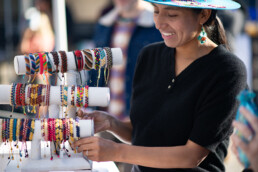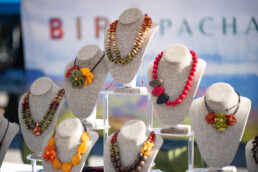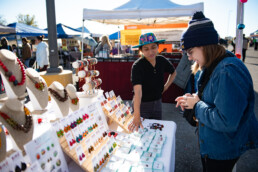Quechua ambassador, marathon runner, research ace — Luz Vargas does it all.
by Cody Bowie
In the high-altitude villages of Peru, where the air is thin and the mountains stand as silent sentinels, a quiet battle is underway. It’s a fight not for land or resources, but for the survival of a language — one that has echoed through the region for centuries. For years, Quechua, the most spoken indigenous language in South America, has been slowly fading from daily life. Spanish has become the language of decision-makers in the region. But one Texas Engineer, driven by her roots, is dedicated to protecting and spreading her native language, no matter where life takes her.
From the remote village of her childhood where she spoke Quechua with her grandmother to the bustling streets of Lima to the Forty Acres, Luz Vargas has carried the language of her ancestors as both a personal legacy and a tool for cultural preservation. Through social media platforms, academic collaborations, and her work with local communities, she’s fighting back against the tide of linguistic extinction. But it’s not just about words — it’s about heritage, identity, and a profound connection to the land she calls home.
Her journey to save Quechua is more than just a mission; it’s a celebration of culture, a call to action, and a reminder that language is a thread that ties generations together even in the face of adversity.
But it’s not her only extraordinary passion.
Luz has run seven marathons. She has her own small jewelry business, Biru Pacha, with a group of Andean artisans.
At the Cockrell School, she is an invaluable resource in the Office of the Associate Dean for Research, where she manages communications, scheduling, travel, and budgets. She also assists with the UT-Portugal Program and helps plan research-related events for the Cockrell community and visits from industry leaders and other research institutions.
Any one of these accomplishments on their own would be an incredible feat. Together, they illustrate Luz’s incredible grit, diversity of talent and compassion for her community.
We sat down with Luz to learn more about all these projects. The conversation has been edited for style and clarity.
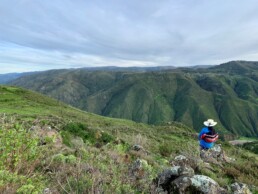
Luz visiting the mountains at her hometown, Santiago de Chocorvos, Huaytará, Huancavelica, Peru.
Tell us about where you’re from.
I grew up in the Andes in Peru. I have very beautiful memories of my childhood, like spending a lot of time with my grandparents. I lived in the mountains until I was 17. That’s where I went to school. I lived with my mother, my brother and my grandparents. My mom was always working in la chacra (field) with the animals.
The Andes in Peru is mostly a very rural area. At that time there was no internet or TV or anything like that. Instead, we listened to the radio. I grew up speaking two languages: Quechua, the language of my mother and grandmother, and Spanish, which is a popular language and is used in schools.
When I graduated high school, I went to Lima, the capital of Peru, for college. I lived with my aunts and uncles for a couple of years. My uncle, Bacilio, is a jeweler, so I helped him make jewelry in his workshop. That’s also when I realized that I wanted to learn English. I’ve always been motivated by wanting to learn more.
I wanted to learn many languages just because I wanted to learn them. I started going to this school for English classes. I remember thinking, oh the numbers are going to be easy. It’s going to be just like Quechua in a way. As long as I learn a few numbers I’ll know all of them. But no. At the first lesson I realized I didn’t know anything. But that’s my motivation: Okay, so this is a new to me, so I just want to learn it all. So, vocabulary by vocabulary, I started learning English. I dedicated myself to learning a few words at the time. I learned most basic English when I was in Lima. When I came to the United States, the real learning began.
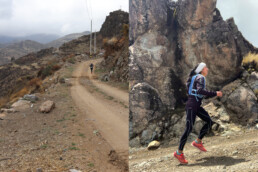
Luz running the virtual St. Jude Marathon in the Andes Mountains in 2020.
You’ve run seven marathons?! How did that start?
Growing up in the mountains of Peru, we listened to marathons on the radio. I would listen closely to the narrator explaining who was winning, and imagined the races. I thought, Wow. I wonder what that’s like. One day I want to run one.
One day, when I was in Memphis driving through the city, I saw a street that was closed, and somebody told me it was for the St. Jude’s Marathon.
I was like, What?! Like, where do you go? What do you need to do to run it? Well, you had to register, so it obviously wasn’t possible for me to run it that day. But I decided I would run it the next year. At that time, I was working with the Ronald McDonald House. And working there, knowing that this race is organized by the hospital as a fundraiser for kids, gave me more of a reason to run.
That first race was tough because I didn’t train. The farthest I think I had ever run before my first marathon was like 12 miles, and I wasn’t sure that I was going to be able to finish. And after the 18th mile, I was just pretty much done. There was a lady next to me; I think she was around 60 years old. A tiny lady was running for several miles with me, and she said, just keep going, pace yourself. Keep going.
I don’t know how I would have finished that race if she wasn’t next to me.
When I finished, I said I am NOT going to do this again. I did my bucket list item. I’m done. But when people started organizing the next year’s race, and I thought about how the fundraising impacts all the families and kids I thought, why not? I trained that time. I met friends, and we ran in groups. And it wasn’t as painful as the first time. I’ve been running now for seven years.
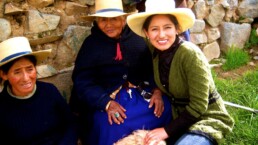
Luz with her mother and grandmother.
What inspired you to focus on the Quechua language?
Quechua is the most spoken indigenous language in South America, but there are other languages, too. And many of them are fading away.
Growing up in the Andes I spoke Quechua and Spanish. In Peru, Quechua was secondary. People knew it but most didn’t use it. Moving out of the country, I felt even farther from the language. I have met several people around my age who moved away and just forgot about the language. And it’s not only through migration that the language is forgotten. It’s also through our systems and how, when you look back, Spanish was imposed on many countries in South America and Central America. I had this realization that I wanted to keep speaking and valuing Quechua.
There wasn’t a lot of support from government organizations for people who speak languages other than Spanish. I learned the language from my grandma because she only speaks Quechua. She never went to the city to do legal paperwork because of her language barrier, and there was no one on the government’s side that supported people like her. And there are a lot of people around her age in the Andes of Peru, Ecuador, Bolivia and all the way to Argentina who only speak Quechua and they did not have access to the basic services.
Video captured in Boulder, Colo. when Luz participated in the University of Colorado Boulder QINTI (Quechua Initiative and Technology) annual meeting.
Tell us how you’re using social media to advocate for Quechua.
In 2019, I started @qichwata_rimay on Instagram. I wanted to help share and value the language. Other Quechua advocates who spoke up and had been well-received, but on the other side, there were those who said Quechua is a spoken language only, and it’s not going to survive.
People connected to their roots have responded positively to these advocates, especially in Peru. Today, there are bilingual classes in some areas in Peru, so I think there has been some progress. But there is still more to do. I’m one little person trying to value the language. There’s support from other people who are doing what I am, trying to also value the language. Today, there are more Quechua-language programs on TV and the radio. There are also podcasts, which are really awesome.
You participated in the Humans Project. What is that, and how does Quechua figure into it?
The Humans Project was an MIT project that collected recordings of voices from people around the world, speaking in their native languages about the meaning of space. The recordings were eventually launched into space.
I got an email from a professor at Harvard, Americo Mendoza-Mori. We had connected because of the Quechua language. Sometimes, I participate in Quechua activities and I collaborate with professors, and we help each other create materials in Quechua. So, I got this email about a search for Quechua language reviewers. I replied, thinking I would never hear from them, but then I got a request for a Zoom meeting. This was in 2022.
So, I reviewed these voices in Quechua, speaking about what is said in their culture about space and their thoughts. And then I had to translate it. It was short, but it was really interesting and sweet. I felt thankful for knowing the language and being able to review it.
And you make jewelry inspired by the culture?
I learned how to make jewelry from my uncle in Lima. Since then, I’ve been making jewelry whenever I can. I initiated this because I wanted to show not just what I make but also what my uncle makes and what other friends and artists make.
When I was living in Peru, I knew many young artists who were just learning, and today, they are talented artisans making embroideries and tapestries. I love art, and I love that it is also connected to my culture. Whenever I go to sell at the Barton Springs Farmers Market, it’s like, oh, hey, this is made by my uncle Bacilio or my friend Fortunata. It’s mostly eco-friendly jewelry and unique, handmade items.
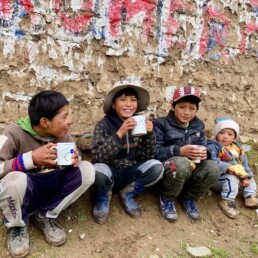
Children from Luz’s hometown, at the Christmas breakfast she hosts.
What inspires you?
It depends on what I’m doing, but in general, it’s helping others. Helping others is very fulfilling for me, but it is also a learning experience. If you use what you learn to help other people around you, or teach other people what you know.
I still try to be connected with my small community and improve it whenever I can. I host a Christmas breakfast with the kids in the school in my hometown, so that’s something meaningful. I also donate part of the sales from Biru Pacha to the school. Because I’ve spent so much time there, it’s beautiful for me to be able to give back.
Luz ends
Follow Luz’s work with Quechua and her unique creations.
